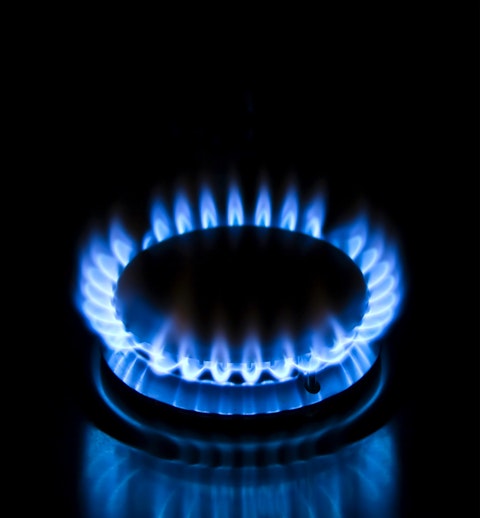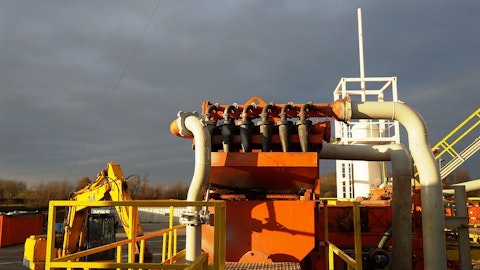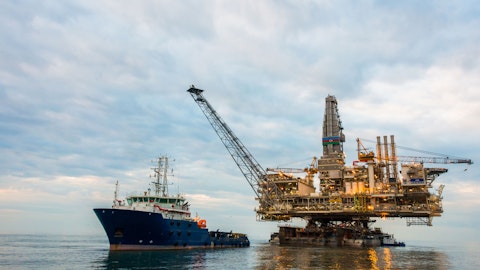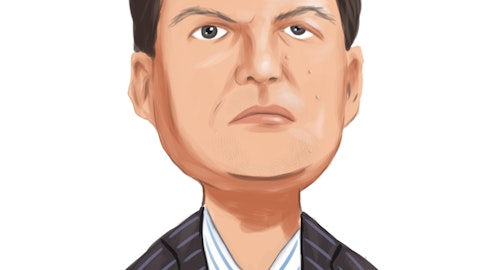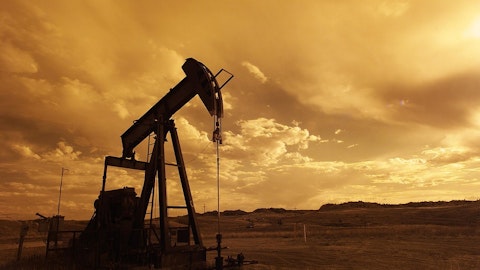Ovintiv Inc. (NYSE:OVV) Q2 2023 Earnings Call Transcript July 28, 2023
Operator: Good morning, ladies and gentlemen and thank you for standing by. Welcome to Ovintiv’s 2023 Second Quarter Results Conference Call. As a reminder, today’s call is being recorded. [Operator Instructions] Please be advised that this conference call may not be recorded or rebroadcast without the expressed consent of Ovintiv. I would now like to turn the conference call over to Jason Verhaest from Investor Relations. Please go ahead, Mr. Verhaest.
Jason Verhaest: Thanks, Michelle, and welcome, everyone to our second quarter ’23 conference call. This call is being webcast and the slides are available on our website at ovintiv.com. Please take note of the advisory regarding forward-looking statements at the beginning of our slides and in our disclosure documents filed on SEDAR and EDGAR. Following prepared remarks, we will be available to take your questions. Please limit your time to one question and one follow-up. I will now turn the call over to our President and CEO, Brendan McCracken.
Brendan McCracken: Good morning. Thank you for joining us. Our outstanding second quarter results continue the strong momentum we’ve created with our focus on execution, and making better wells for lower costs. We exceeded every one of our guidance targets on the quarter. We also closed two compelling transactions that have simplified our portfolio, extended our premium inventory enhanced our go-forward capital efficiency and expanded our margins. I’ll speak more to the progress we are making with the newly acquired Permian assets in a moment, but first, I want to touch on our second quarter results. Our production outperformance in the quarter is coming from our legacy business. The accelerated close was included with our previously issued 2Q guidance, and the new assets have performed right in line with our expectations during the quarter.
Quarter was a beat across the board from production to capital to per unit costs. We exceeded our targets delivered on both efficiencies and well productivity. Greg will cover this in more detail in a moment, but our oil production outperformance is the result of our completion design innovations and our capital reductions are the result of our execution efficiency gains. As a result, we’ve raised our full year production guidance and lowered our full year capital guide. Across the portfolio, the intense focus our teams have placed on operational execution continues to deliver results, especially in the Permian, where we posted another quarter of record operational efficiencies. Our Permian team has seamlessly integrated the new assets into our existing operations.
We were pleased to close the transaction early and we’ve already finished resetting activity on the new acreage. We are currently at our expected run rate activity for the rest of the year with 5 rigs and three completion crews in the Permian. We are also already executing our proven drilling and completion designs on our new assets, and we fully expect — we expect to have our first fully Ovintiv design wells online later in the fourth quarter. On second quarter production, we exceeded the top end of our guidance on oil, gas and NGLs were coming in below the low end of guidance for capital. These results were driven by strong well performance from each asset in our portfolio, successful base decline management on our older vintage wells.
Tailwinds from lower natural gas royalty rates in the Montney and capital savings from continued record setting operational performance across the asset base. We also returned approximately $172 million to our shareholders through share buybacks and our recently increased base dividend. I’ll now turn the call over to Corey to cover our financial results.
Corey Code: Thanks, Brendan, and good morning. In addition to the great operational results Brendan outlined, we also delivered strong financial results in the quarter with earnings per share of $1.34 and cash flow per share of $2.79, beating consensus estimates. We remain free cash flow positive despite the impact of transaction-related costs and the incremental capital associated with the early close of the Permian Basin acquisition. We also saw a strong per unit cost performance with operating expense, transportation and processing expense and production, mineral and other taxes coming in below the midpoint of guidance on a combined basis. Operating expense also benefited from a $23 million recovery of prior year’s costs.
We issued debt during the quarter to finance a portion of the Permian acquisition, and we are very pleased with our resulting capital structure and the maintenance of our investment grade rating and stable outlook from all four credit rating agencies. At quarter end, our leverage ratio was 1.7x, and this included all of the acquisition finance debt, but only 19 days of EBITDA from the acquired assets. We remain committed to our mid-cycle leverage target of 1x or about $4 billion of total debt, assuming mid-cycle prices. The maturity profile of our recently issued bonds will allow us to optimize our debt pay down schedule as we work towards that target. While debt reduction is a big area of focus for us in the near-term, our shareholder return framework has not changed.
We will continue to distribute at least 50% of post-dividend free cash flow to our shareholders with the remaining 50% going to the balance sheet. I would like to note that the amount of cash available for buybacks in our shareholder return framework is determined each quarter on a discrete basis. Yesterday, we provided our third quarter guidance and updated our 2023 full year guide to reflect the efficiencies, cost savings and improved well productivity we’ve seen year-to-date across the portfolio. In the third quarter, we expect to see total production average 540,000 to 560,000 BOE per day, with oil and condensate production of 202,000 to 208,000 barrels per day. We expect oil and condensate production to continue to grow through the fourth quarter and averaged 210,000 barrels per day in the second half of the year.
This reflects the production momentum from the new Permian assets as we bring acquired WIPs online. The production profile will normalize by midyear 2024 with the second half 2024 oil and condensate production stabilizing at 200,000 barrels per day. We also raised our full year natural gas guide due to strong well performance across the portfolio. Third quarter capital spending will be the peak for the year at $840 million to $890 million. This reflects the shift from a 10 rig program in the Permian at the time the acquisition closed to our current 5 rig program. And the capital associated with the higher level of activity as we work to bring the acquired wells in progress online by year-end. We expect to bring online about 100 wells in the third quarter, with roughly half of these from the acquired Permian assets.
We’ve updated our full year guidance with higher production and lower capital investment. The new guide incorporates the operational and capital efficiencies we’ve achieved our strong well productivity performance and the success we had in offsetting base production declines. In addition to increased capital efficiency, we also expect to see increased cash cost savings. We divested a relatively higher cost asset in the Bakken and added a relatively lower cost asset in the Permian. We anticipate company level savings of approximately 5% on a combined basis for OpEx and T&P in the second half of the year. We also provided an update to our hedging positions with the materials yesterday with about 50% of our WTI exposure and about 40% of our NYMEX gas exposure hedged for the next 12 months.
Capital efficiency is a key focus across the organization as efficiently converting our resource into cash flow is a crucial aspect of our durable returns approach. Ovintiv’s capital efficiency ranks top tier among our peers is creating exceptional value in today’s volatile commodity and macroeconomic environment. In 2024, we expect to produce more than 200,000 barrels of oil in condensate per day for about $2.3 billion of CapEx at the midpoint. That’s a 15% year-over-year capital efficiency improvement with an associated increase of 30,000 barrels per day of oil and condensate versus our original 2023 guide. This increase in capital efficiency generates higher returns on invested capital and allows us to deliver higher cash returns to our shareholders.
When compared to our peers, Ovintiv’s 2024 capital program will require about $250 million less capital to deliver the same production at the midpoint of our 2024 oil and condensate production and capital guides. I will now turn the call over to Greg to cover our operational highlights.
Gregory Givens: Thanks, Corey. As Brendan noted, our top priority over the last 1.5 months has been the efficient and seamless integration of the new Permian assets into our existing operations. And the team has done a very impressive job. With 5 rigs and 3 frac spreads currently running across 180,000 acres in the play, we are already at our run rate activity for the rest of the year. Our results in the Permian year-to-date have been stellar, and we are very excited to unleash our proven development model on the acquired acreage. The wells on the new acreage are performing in line with average 2022 Midland Basin productivity rates, and we see opportunities to increase well performance and capital efficiency as we apply our drilling and completion approach to these assets.
We have already begun deploying our proven optimization techniques on completion design, artificial lift and accelerated cycle times on the wells that were already in progress when the acquisition closed. We are also streamlining planning and logistics across our combined Permian position, improving efficiency versus the three separate operating companies that were previously planning and executing work on each of their individual footprints. We have already reduced offset frac hits as we’ve optimized our program across the combined position. As Brendan noted, we expect to see our first end-to-end Ovintiv designed wells online in the fourth quarter. Our efforts on completion design and particularly on stage architecture, continue to deliver leading well performance across our Permian acreage.
The chart on the right shows the 2022 Midland Basin industry average compared to our 2023 type curve and the wells we brought online in the first half of the year. Our year-to-date oil performance is among the highest we’ve ever delivered in the Permian. It’s important to note that the well outperformance is the result of the advances we’ve made to enhance completion design, including stage architecture, fluid chemistry and proppant loading. Our cube development approach has stayed consistent and our program well spacing is unchanged year-over-year. These results were spread out across our acreage footprint and our enhanced completions are being executed without an increase to completed well cost. As we are able to deploy our leading efficiencies into making better wells.
While the recent well performance is outstanding, we remain thoughtful with our go-forward type curve assumptions. In the third quarter alone, we will bring on more than 50% more wells than we did in the entire first half of the year in the Permian. Once we see the results from these completions as well as the longer term production from the previous wells, we will have a much better handle on the repeatable uplift we can incorporate into our forecast. I’d like to take a quick moment to recognize the outstanding performance from our team in the Permian this quarter. Our operations continued to hit on all cylinders, setting new performance records while seamlessly integrating our newly acquired assets. These results are allowing us to deliver stronger well performance through completions optimization and improved stage architecture in a cost-effective manner.
For example, our second quarter average completion speed at well over 3,500 feet per day is about 40% faster than our average speed over the last 3 years and 11% faster than our first quarter average. Using the same time frame comparison, we now pump 80% more proppant per day and 45% more fluid. Our enhanced performance is delivering better wells at lower cost, improving our capital efficiency. We continue to deliver impressive results across our portfolio, and our year-to-date performance in the Montney is no exception. Ovintiv wells continue to dominate the list of most productive wells in the play on a total BOE basis. Over the last 12 months, we have brought on the top 31 wells in the Montney and 36 of the top 50. I want to be clear that these impressive production rates do not come with a higher price tag.
The average cost of the 36 wells highlighted in the chart was $4.5 million per well, making Montney wells the lowest cost in our portfolio. The great returns we generate in the play are further enhanced by our market diversification strategy, which we use to manage flow assurance and price risk. With almost all our Montney gas pricing outside of AECO, we realized 97% of NYMEX on a pre-hedge basis, and our condensate received 96% of WTI during the quarter. In the Uinta, we continue to deliver some of the strongest oil well results in North America. We recently brought on our 3 Well Jorgensen Pad in Duchesne County with strong IP30 rates of 1,850 barrels of oil per day per well. Our large contiguous land base of approximately 130,000 net acres as multiple benches with about 1,000 feet of collective pay.
It is 80% undeveloped, which translates into a significant inventory runway. As we previously noted, we recently secured additional rail capacity to the Gulf Coast, and we currently rail about 30% to 40% of our volumes there. This scalable option supports our future development plans for the play. Due to the highly oily nature of display in the first half of the year, the Uinta tied the Permian for the highest operating margin in our portfolio. Given the current gas and NGL markets, we’ve reduced our activity in the Anadarko Basin in the back half of the year. That said, the Anadarko is expected to be our top free cash flow generating asset in 2023 and remains a premier multiproduct option in our portfolio. The team continues to work the asset hard, cutting our base declines in half since 2021.
They also wrapped up this year’s activity on a high note, realizing a 25% increase in drilling feet per day in the quarter versus our 2022 average. I will now turn the call back to Brendan.
Brendan McCracken: Thanks, Greg. And before we move to Q&A, I’d like to sum up the key takeaways from today’s call. I’d like to commend our team for the outstanding results year-to-date. Our focus on execution excellence has shown up across our portfolio. We have successfully integrated the new Permian assets, and our team is already applying our development model to the wells in progress. The asset performance has been strong, and we see opportunities for further gains going forward. We are increasing full year 2023 production guidance and lowering capital spending. We are one of the most capital efficient operators in the industry, and our 2024 program is advantaged compared to our peers in its ability to deliver more barrels for fewer dollars.
We are committed to debt reduction while returning significant cash to our shareholders. Our shareholder returns framework remains unchanged and the amount available to shareholders will be determined by the same reliable approach every quarter. Over the long-term, we believe that value creation in the E&P space will come from companies that can durably generate both superior return on invested capital and return of cash to shareholders. We are well-positioned to deliver on this value proposition with a deep premium inventory, leading capital efficiency to convert that inventory to free cash flow, and the disciplined capital allocation to make sure those returns flow through to the bottom line and to our shareholders. This concludes our prepared remarks.
Michelle, we are now ready to open the line for questions.
See also 20 Countries With Highest Rates Of AIDS and 30 Best Excuses to Get Out of Work Provided By AI Chatbots.
Q&A Session
Follow Ovintiv Inc. (NYSE:OVV)
Follow Ovintiv Inc. (NYSE:OVV)
Operator: [Operator Instructions] Your first question comes from Arun Jayaram at JPMorgan. Please go ahead.
Arun Jayaram: Yes. Good morning. Brendan, I was wondering if you could shed more insights on just the well productivity gains that you’re seeing, particularly in the Permian. Greg mentioned stage architecture, fluid and completion design, but I was wondering if you could give us more insights on that — the potential repeatability. And I was also wondering if you’ve tested this in perhaps some areas outside of the core, and if you have any maybe preliminary results to share.
Brendan McCracken: Yes. Arun, good morning. I appreciate the question and the pickup on the well performance. Obviously, really excited about what we are seeing there. And as we reported here today, we’ve now got 44 wells of the program online with production history and the performance is well above our 2023 type curve, which we are obviously enthused about. Really, the driver we are seeing here is the completion design piece that you mentioned. This has been a multiyear effort by our team to zero-in on the true causal factors that can drive well performance and increased recovery from shale. And it’s not just in the Permian, we’re deploying this across the whole portfolio. And really, I like to kind of break it down into three buckets, Arun, in terms of what the team has been driving on, and I probably won’t do service to the detail and the multiple factors that are driving here, the three buckets we see really are the stage architecture, which is our phrase for the combination of cluster design, cluster spacing and then, of course, the sand and water loading that we are feeding in through those clusters.
And the whole point of that stage architecture engineering is to get a more conductive fracture network more consistently placed along the entire lateral. And of course, that becomes more important as we drill longer laterals in these plays and drive efficiencies that way. So that’s the first bucket. The second bucket is kind of what we call chemistry, and that’s using the chemistry of the frac fluid try and enhance the permeability of oil in that fracture network. And so then, as a consequence, get more recovery from the poor system in place. And then the final bucket is really got a few things in it, but really, it’s this idea of real-time frac monitoring. And the approach here is traditionally in our industry the approach was the engineers in the office would write up a frac program and send it out to the field and then the field would pump it.
And then sometime down the road, there would be a look back on and potentially optimization occur in subsequent wells. And what we are trying to — the network we are trying to crack with technology and telemetry is to be able to do that real time. And the learning from the signals we are getting back subsurface well we are pumping and then tune our frac design as we go and as a consequence, just be more efficient with that frac design, but also get more recovery along that long lateral. So really, those are the three buckets I’d speak to, Arun.
Arun Jayaram: It sounds like a nice endorsement of how a smart fleet technology, Jeff Miller. My follow-up, Brendan, is have you tested this kind of completion design outside of the core. And could there be any implications of, call it, Tier 2 locations on the map where you could boost the overall productivity to perhaps mimic Tier 1 type of economics?
